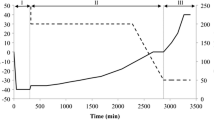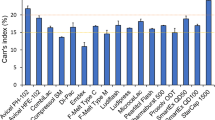Abstract
We report here on improved uniformity of blends of micronised active pharmaceutical ingredients (APIs) using addition of spherical agglomerates of lactose and enhanced blend flow to improve tablet content uniformity with higher API loads. Micromeritic properties and intra-particle porosity (using nano-computed X-ray tomography) of recently introduced spherical agglomerates of lactose and two standard lactose grades for the direct compression processes were compared. Powder blends of the individual lactose types and different micronised API drug loads were prepared and subjected to specific conditions that can induce API segregation. Tablet content uniformity during direct compression was related to the lactose material attributes. The distinctive micromeritic properties of the lactose types showed that spherical agglomerates of lactose had high intra-particle porosity and increased specific surface area. The stability of binary blends after intense sieving was governed by the intra-particle porosity and surface roughness of the lactose particles, which determined the retention of the model substance. Greater intra-particle porosity, powder specific surface area, and particle size of the spherical agglomerates provided greater adhesion of micronised particles, compared to granulated and spray-dried lactose. Thus the spherical agglomerates provided enhanced final blend flow and uniformity of tablet content at higher drug loads.
Graphical Abstract








Similar content being viewed by others
Notes
Reprinted from International Journal of Pharmaceutics, 516/1–2, Dejan Lamešić, Odon Planinšek, Zoran Lavrič, Ilija Ilić, Spherical agglomerates of lactose with enhanced mechanical properties, 247–257, 2017, with permission from Elsevier.
References
Bi M, Sun CC, Alvarez F, Alvarez-Nunez F. The manufacture of low-dose oral solid dosage form to support early clinical studies using an automated micro-filing system. AAPS PharmSciTech. 2011;12(1):88–95. https://doi.org/10.1208/s12249-010-9549-y.
Chen L, He Z, Kunnath KT, Fan S, Wei Y, Ding X, et al. Surface engineered excipients: III. Facilitating direct compaction tableting of binary blends containing fine cohesive poorly-compactable APIs. Int J Pharm. 2019;557:354–65. https://doi.org/10.1016/j.ijpharm.2018.12.055.
Leane M, Pitt K, Reynolds G, Anwar J, Charlton S, Crean A, et al. A proposal for a drug product manufacturing classification system (MCS) for oral solid dosage forms. Pharm Dev Technol. 2015;20(1):12–21. https://doi.org/10.3109/10837450.2014.954728.
Ely DR, Carvajal MT. Determination of the scale of segregation of low dose tablets using hyperspectral imaging. Int J Pharm. 2011;414(1–2):157–60. https://doi.org/10.1016/j.ijpharm.2011.05.027.
Gentzler M, Michaels JN, Tardos GI. Quantification of segregation potential for polydisperse, cohesive, multi-component powders and prediction of tablet die-filling performance - a methodology for practical testing, re-formulation and process design. Powder Technol. 2015;285:96–102. https://doi.org/10.1016/j.powtec.2015.04.037.
He X, Han X, Ladyzhynsky N, Deanne R. Assessing powder segregation potential by near infrared (NIR) spectroscopy and correlating segregation tendency to tabletting performance. Powder Technol. 2013;236:85–99. https://doi.org/10.1016/j.powtec.2012.05.021.
Jaklič M, Kočevar K, Srčič S, Dreu R. Particle size-based segregation of pharmaceutical powders in a vertical chute with a closed bottom: an experimental evaluation. Powder Technol. 2015;278:171–80. https://doi.org/10.1016/j.powtec.2015.03.021.
Liu R, Yin X, Li H, Shao Q, York P, He Y, et al. Visualization and quantitative profiling of mixing and segregation of granules using synchrotron radiation X-ray microtomography and three dimensional reconstruction. Int J Pharm. 2013;445(1–2):125–33. https://doi.org/10.1016/j.ijpharm.2013.02.010.
Asachi M, Hassanpour A, Ghadiri M, Bayly A. Experimental evaluation of the effect of particle properties on the segregation of ternary powder mixtures. Powder Technol. 2018;336:240–54. https://doi.org/10.1016/j.powtec.2018.05.017.
Roskilly SJ, Colbourn EA, Alli O, Williams D, Paul KA, Welfare EH, et al. Investigating the effect of shape on particle segregation using a Monte Carlo simulation. Powder Technol. 2010;203(2):211–22. https://doi.org/10.1016/j.powtec.2010.05.011.
Alizadeh M, Hassanpour A, Pasha M, Ghadiri M, Bayly A. The effect of particle shape on predicted segregation in binary powder mixtures. Powder Technol. 2017;319:313–22. https://doi.org/10.1016/j.powtec.2017.06.059.
Tang P, Puri VM. Methods for minimizing segregation: a review. Part Sci Technol. 2004;22(4):321–37. https://doi.org/10.1080/02726350490501420.
Xie L, Wu H, Shen M, Augsburger LL, Lyon RC, Khan MA, et al. Quality-by-design (QbD): effects of testing parameters and formulation variables on the segregation tendency of pharmaceutical powder measured by the ASTM D 6940–04 segregation tester. J Pharm Sci. 2008;97(10):4485–97. https://doi.org/10.1002/jps.21320.
Scheibelhofer O, Balak N, Wahl PR, Koller DM, Glasser BJ, Khinast JG. Monitoring blending of pharmaceutical powders with multipoint NIR spectroscopy. AAPS PharmSciTech. 2013;14(1):234–44. https://doi.org/10.1208/s12249-012-9910-4.
Harnby N. An engineering view of pharmaceutical powder mixing. Pharm Sci Technol Today. 2000;3(9):303–9. https://doi.org/10.1016/s1461-5347(00)00283-2.
Sommier N, Porion P, Evesque P, Leclerc B, Tchoreloff P, Couarraze G. Magnetic resonance imaging investigation of the mixing-segregation process in a pharmaceutical blender. Int J Pharm. 2001;222(2):243–58. https://doi.org/10.1016/s0378-5173(01)00718-9.
Xiao H, Fan Y, Jacob KV, Umbanhowar PB, Kodam M, Koch JF, et al. Continuum modeling of granular segregation during hopper discharge. Chem Eng Sci. 2019;193:188–204. https://doi.org/10.1016/j.ces.2018.08.039.
Teżyk M, Jakubowska E, Milczewska K, Milanowski B, Voelkel A, Lulek J. The influence of direct compression powder blend transfer method from the container to the tablet press on product critical quality attributes: a case study. Drug Dev Ind Pharm. 2017;43(6):911–6. https://doi.org/10.1080/03639045.2016.1278016.
Lakio S, Siiriä S, Räikkönen H, Airaksinen S, Närvänen T, Antikainen O, et al. New insights into segregation during tabletting. Int J Pharm. 2010;397(1–2):19–26. https://doi.org/10.1016/j.ijpharm.2010.06.041.
Mateo-Ortiz D, Muzzio FJ, Méndez R. Particle size segregation promoted by powder flow in confined space: the die filling process case. Powder Technol. 2014;262:215–22. https://doi.org/10.1016/j.powtec.2014.04.023.
Williams JC. The segregation of particulate materials. A review Powder Technol. 1976;15(2):245–51. https://doi.org/10.1016/0032-5910(76)80053-8.
McCarthy JJ. Turning the corner in segregation. Powder Technol. 2009;192(2):137–42. https://doi.org/10.1016/j.powtec.2008.12.008.
Li H, McCarthy JJ. Cohesive particle mixing and segregation under shear. Powder Technol. 2006;164(1):58–64. https://doi.org/10.1016/j.powtec.2005.12.018.
Li H, McCarthy JJ. Controlling cohesive particle mixing and segregation. Phys Rev Lett. 2003;90(18):4. https://doi.org/10.1103/PhysRevLett.90.184301.
Yip CW, Hersey JA. Ordered powder mixing. Nature. 1976 Jul 1;262(5565):202–3. https://doi.org/10.1038/262202a0.
Hersey JA. Ordered mixing: a new concept in powder mixing practice. Powder Technol. 1975;11(1):41–4. https://doi.org/10.1016/0032-5910(75)80021-0.
Alyami H, Dahmash E, Bowen J, Mohammed AR. An investigation into the effects of excipient particle size, blending techniques & processing parameters on the homogeneity & content uniformity of a blend containing low-dose model drug. PLoS ONE. 2017;12(6):1–19. https://doi.org/10.1371/journal.pone.0178772.
Johnson MCR. Powder mixing in direct compression formulation by ordered and random processes. J Pharm Pharmacol. 1979;31(1):273–6. https://doi.org/10.1111/j.2042-7158.1979.tb13500.x.
Mao C, Thalladi VR, Kim DK, Ma SH, Edgren D, Karaborni S. Harnessing ordered mixing to enable direct-compression process for low-dose tablet manufacturing at production scale. Powder Technol. 2013;239:290–9. https://doi.org/10.1016/j.powtec.2013.02.016.
Swaminathan V, Kildsig DO. The effect of particle morphology on the physical stability of pharmaceutical powder mixtures: the effect of surface roughness of the carrier on the stability of ordered mixtures. Drug Dev Ind Pharm. 2000;26(4):365–73. https://doi.org/10.1081/ddc-100101242.
Gohel MC, Jogani PD. A review of co-processed directly compressible excipients. J Pharm Pharm Sci. 2005;8(1):76–93.
Lamešić D, Planinšek O, Lavrič Z, Ilić I. Spherical agglomerates of lactose with enhanced mechanical properties. Int J Pharm. 2017 Jan 10;516(1–2):247–57. https://doi.org/10.1016/j.ijpharm.2016.11.040.
Lamešić D, Planinšek O, German II. Modified equation for particle bonding area and strength with inclusion of powder fragmentation propensity. Eur J Pharm Sci. 2018 May;121:218–27. https://doi.org/10.1016/j.ejps.2018.05.028.
Sundell-bredenberg S, Nystrom C. The possibility of achieving an interactive mixture with high dose homogeneity containing an extremely low proportion of a micronised drug. 2001;12:285–95. https://doi.org/10.1016/s0928-0987(00)00176-7.
Brunauer S, Emmett PH, Teller E. Adsorption of gases in multimolecular layers. J Am Chem Soc. 1938;60(2):309–19. https://doi.org/10.1021/ja01269a023.
Hausner HH. Friction conditions in a mass of metal powder. Int J Powder Met. 1967;3(4):7–13.
Shah UV, Karde V, Ghoroi C, Heng JYY. Influence of particle properties on powder bulk behaviour and processability. Int J Pharm. 2017;518(1–2):138–54. https://doi.org/10.1016/j.ijpharm.2016.12.045.
Farber L, Tardos G, Michaels JN. Use of X-ray tomography to study the porosity and morphology of granules. 2003;132:57–63. https://doi.org/10.1016/S0032-5910(03)00043-3.
Zeitler JA, Gladden LF. In-vitro tomography and non-destructive imaging at depth of pharmaceutical solid dosage forms. Eur J Pharm Biopharm. 2008;71(1):2–22. https://doi.org/10.1016/j.ejpb.2008.08.012.
Alexander B, Roddy M, Brone D, et al. A method to quantitatively describe powder segregation during discharge from a vessel. Pharm. Tech. 2000 Yearbook. 6–21.
Marucci M, Al-Saaigh B, Boissier C, Wahlgren M, Wikström H. Sifting segregation of ideal blends in a two-hopper tester: segregation profiles and segregation magnitudes. Powder Technol. 2018;331:60–7. https://doi.org/10.1016/j.powtec.2018.01.070.
Acknowledgements
The authors would like to thank dr. Ilija German Ilić from the Faculty of Pharmacy, University of Ljubljana, for support for the direct compression experiments.
Funding
The authors acknowledge financial support from the Slovenian Research Agency (research core funding, No. P1-0189).
Author information
Authors and Affiliations
Contributions
Dejan Lamešić: concept, design of the work, acquisition, analysis and interpretation of the data, drafting the manuscript.
Blaž Grilc: design of the work, acquisition, analysis and interpretation of the data, revising the work
Robert Roškar: acquisition, analysis and interpretation of the data, revising the work
Selina Kolokytha: acquisition, analysis and interpretation of the data, revising the work
Jürgen Hofmann: design of the work, acquisition, analysis and interpretation of the data, revising the work
Andreas Malekos: acquisition, analysis and interpretation of the data, revising the work
Rolf Kaufmann: design of the work, revising the work
Odon Planinšek: design of the work, revising the work, final approval for published work
Corresponding author
Ethics declarations
Conflict of Interest
The authors declare the granted patent for spherical agglomerates of lactose (US 10,568,837 B2).
Additional information
Publisher's Note
Springer Nature remains neutral with regard to jurisdictional claims in published maps and institutional affiliations.
Rights and permissions
About this article
Cite this article
Lamešić, D., Grilc, B., Roškar, R. et al. Spherical Agglomerates of Lactose Reduce Segregation in Powder Blends and Improve Uniformity of Tablet Content at High Drug Loads. AAPS PharmSciTech 23, 17 (2022). https://doi.org/10.1208/s12249-021-02150-3
Received:
Accepted:
Published:
DOI: https://doi.org/10.1208/s12249-021-02150-3




